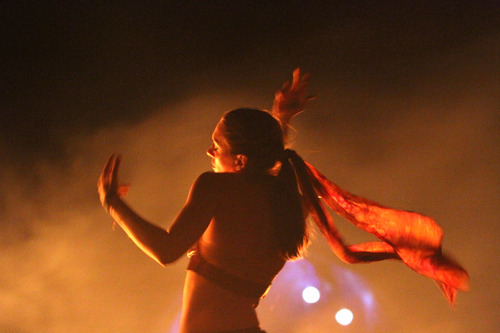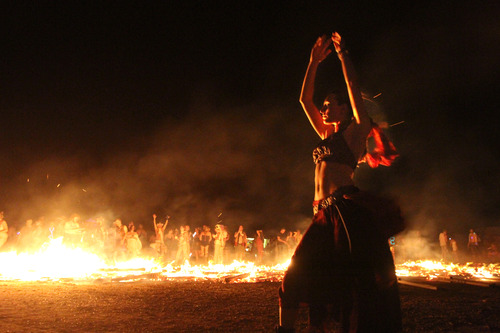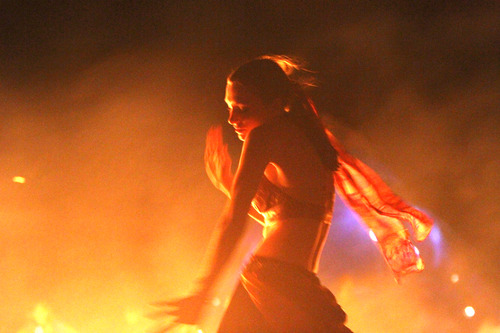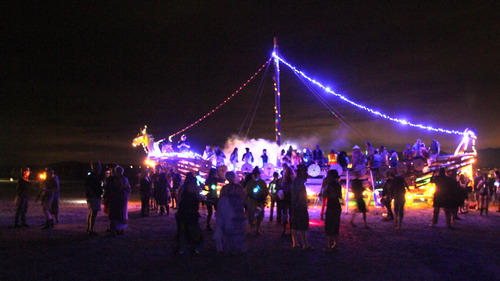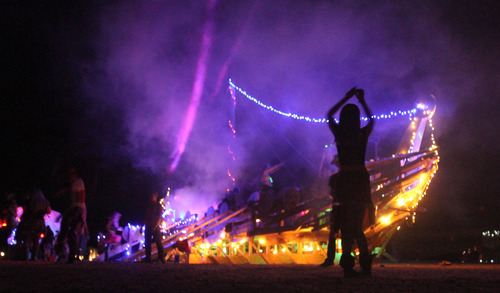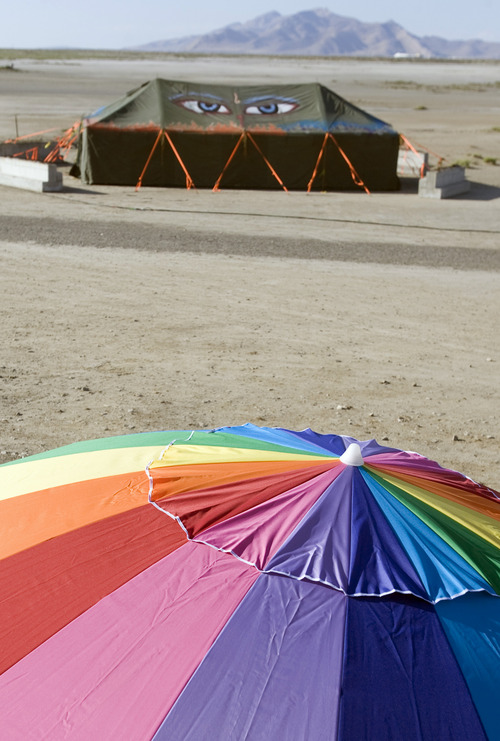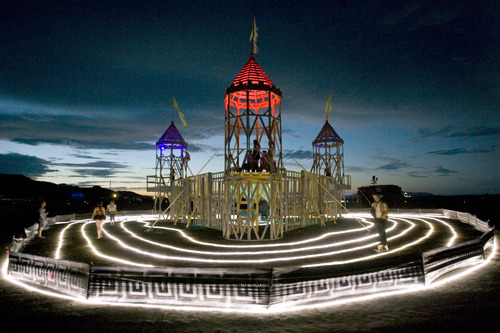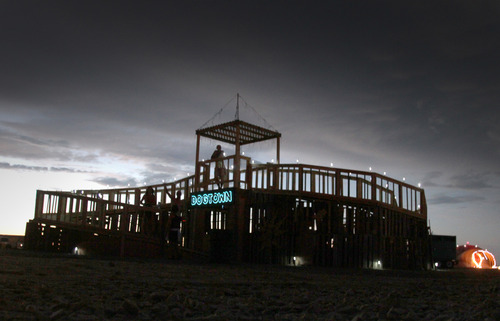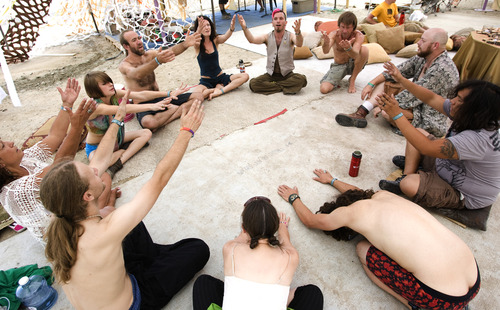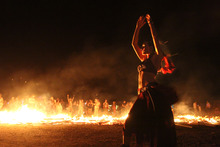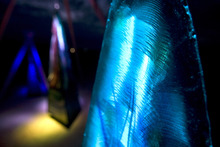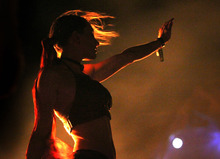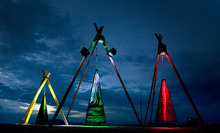This is an archived article that was published on sltrib.com in 2013, and information in the article may be outdated. It is provided only for personal research purposes and may not be reprinted.
Grantsville • Parker's not wearing pants, but if you've noticed that you've already missed the point.
Retired and an avid burner, he's walking through the center camp at the 15th annual Element 11 — Utah's regional Burning Man . With the summer sun high and the buildings nearby ready to incinerate, the most important observation isn't whether anyone is wearing clothes or not.
Music pervades every part of the makeshift community of about 1,200 that filled the festival grounds at Bonneville Seabase 5 miles south of Grantsville.
The buildings in the open center circle are set to burn. Three 30-foot-high wood buildings cast shadows on the salty sand, and people are painting and hanging artwork in the shade of their camps.
"Welcome home," the greeters say, whether it's your first or 15th time at Element 11, a four-day event that ends Sunday.
RVs, buses, cars and trucks rumble onto the desert site and stake claim tight with their neighbors. There are no rules here. People dance down rocky streets. Many are in bright and scanty costumes. Monkey chants battle electronic music. These, too, aren't the observations that are important to note.
It's not a gathering of debauched crazies. The main goal isn't to make a point or rally behind a cause. They're celebrating the idea that when unbounded by restrictions, people can do extraordinary things.
As Grantsville Mayor Brent Marshall says after taking a driving tour through camp, "These are some people with some really artistic imaginations."
Take Dean Quada's Labyrinth Infinitum. The 47-foot by 25-foot clean wooden structure was this year's main effigy and took months to plan and weeks to build. An eternal walkway wraps infinitely in an ascending and descending figure eight.
Typically, everything constructed at Element 11 is burned. There are few physical attachments to the celebration. Artists and volunteers spend a year creating their work, and within a matter of minutes, it's destroyed.
The Valhalla ship is the exception. The 70-foot-long ship made of barnyard wood has sat for a year, corroding in the air west of the Great Salt Lake. It was spared from flames last year in what's become a new tradition of saving a legacy piece.
But Friday night, in the sustained northbound 30 mph winds, Tooele County volunteer fire crew on site, the ship meets its final voyage.
Members of the Pineapple Camp ignite the end of a burning spear and throw it into the center of the skeleton ship. Pyrotechnics ignite. Blinding flashes of white light pierce the darkness. The wind sends the spear's flame to the front of the ship, it meets with more fuel, and the ship begins its fiery end.
"The whole idea is love it and leave it," Quada says. "You watch them burn. It's like almost watching those experiences burn up. You have the memory, but the physical piece of it is gone."
—
Free expression • Burning Man in the Black Rock Desert in Nevada is a staple for free and eccentric expression. Last year, its attendance topped 60,000, and old Burners talk at Element 11 about the importance of regional burns.
Regional burns in Colorado, California and this one in Utah promote a free and open culture to think, say and live as you want, says a woman known as Trinity, and they're becoming more important.
The whole celebration seems deeply rooted in American freedom, but without the capitalist bent.
There are no sponsors. There are no vendors. There are no headlining bands. For four days in the fine salt and sand, Element 11 is a city with no zoning laws for its streets. People co-exist and blend into a compounded culture. It's a lawless landscape with people behaving any way they wish. There is no violence. Alcohol abounds.
It's a gathering of artistic expression that seems dead set on extravagance, not hippie ideals.
Generators hum constantly through the night, powering sound or lights for camps. Propane tanks power grills and keep RV fridges cool.
Everyone is on Playa Time, lingo for laid back and free of outside restrictions. There are a few taboos, but generally what they do, how they interact, what they scream from a bullhorn at 2:30 a.m., all are guided by the emotion and energy around the festival at any given moment.
Everyone who paid the $90-$150 ticket price — a fee paid by even the board of directors and volunteers — is trying to expand a culture counter to what happens in the Default World outside.
For someone who hasn't properly experienced Element 11, the sight of a man getting his butt cheeks paddled upon entry might seem a bit brash.
But these people, depending on what label or lens is applied, lead by example to create a civic-minded community focused on sharing, human interaction and art. Oh, and fire. That's a big part holding the party together.
But that's not the point of Element 11.
Ten thousand hours of labor — all volunteer — created Element 11, says organizer and local artist Aspen Moon. Moon is director of operations for the newly recognized nonprofit event. The group aims to give 75 percent of its net profits to art projects. This year, that meant about $16,000 in grants.
"I'm really interested in something that stirs a concept, stirs emotion, stirs a feeling, you know?" Moon says. He was talking about his paintings, which are rooted in spiritual geometry, but it seems to fit his thoughts on fostering the makeshift community.
—
Regional personalities • While everyone has an opinion on whether Element 11 and other regional burns should emulate Burning Man or take on their own personality, Moon and the directors intensely planned the event to let the camps show up and take on its own living personality.
Still, the folks from Southern California in Bat Country camp said Utah's burn is "like taking a piece of Burning Man and putting it in Utah," and this festival is respected for its adherence to the 10 principles of Burning Man.
Large and complex electric lighting sits atop "mutant vehicles," cars turned into creatures that crawl the desert sand and rocks day and night, most playing music.
A large pair of dentures on wheels shines fluorescent while it chatters around a crowd of people dancing to its music. Three jellyfish from the Jellyfish Camp slither to the base of a small hill on the northeast corner of camp Saturday morning, blasting its house music for all to hear at 3 a.m.
The whole spectacle is a lot of commitment for 66 hours of Playa Time fun. It can all be quite emotional for those who volunteer year after year. Markham Sound watches through a pair of goggles the ending of the Valhalla ship.
The ship was dedicated to 33-year-old Daniel Fonseca, who died three months before the festival after years of attendance and several years with cancer.
Fonseca was one more string that makes the ship hard to let go.
As the flames danced and embers blew north, Sound looks on from the front of the gathered circle of people. "It's got the wind at its back now," he says. "It's sailing."



